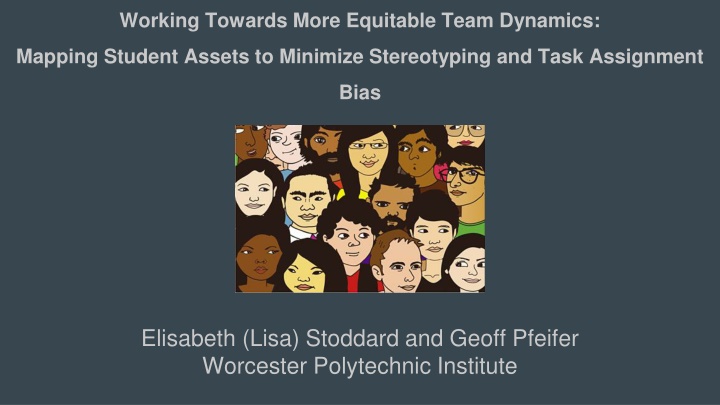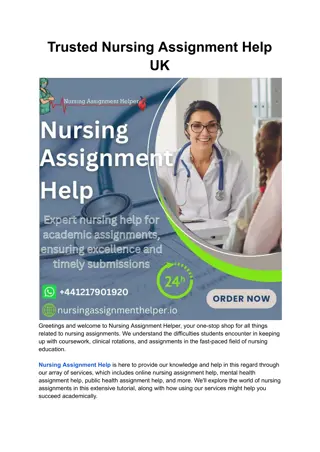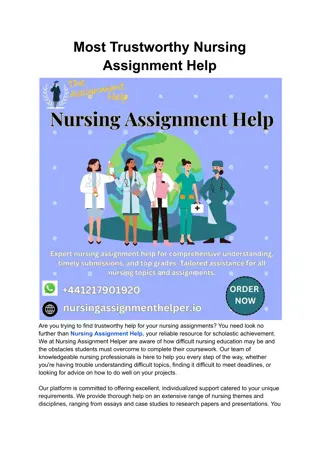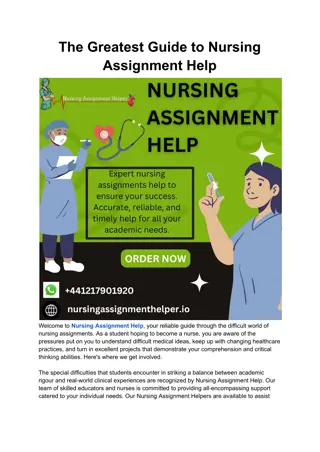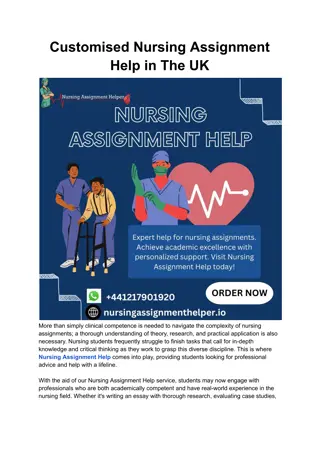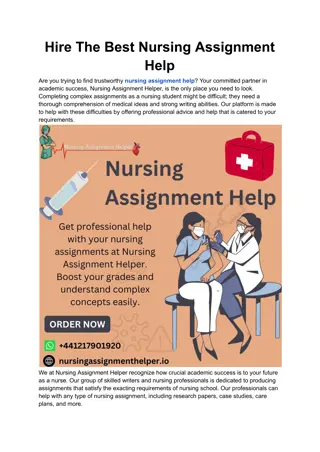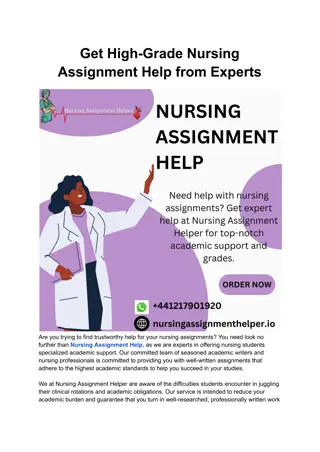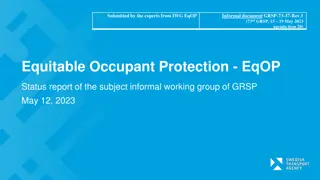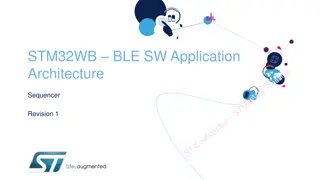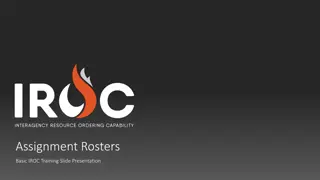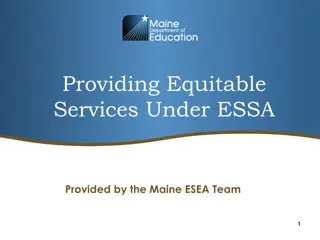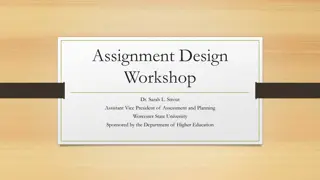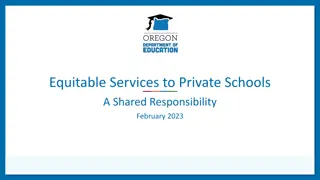Enhancing Team Dynamics for Equitable Task Assignment
Exploring the importance of diverse teams in achieving innovative outcomes, addressing common team dynamics issues among students, especially women and students of color, and sharing experiences of intellectual marginalization in team settings, with a focus on minimizing stereotyping and bias in task assignment.
Download Presentation

Please find below an Image/Link to download the presentation.
The content on the website is provided AS IS for your information and personal use only. It may not be sold, licensed, or shared on other websites without obtaining consent from the author.If you encounter any issues during the download, it is possible that the publisher has removed the file from their server.
You are allowed to download the files provided on this website for personal or commercial use, subject to the condition that they are used lawfully. All files are the property of their respective owners.
The content on the website is provided AS IS for your information and personal use only. It may not be sold, licensed, or shared on other websites without obtaining consent from the author.
E N D
Presentation Transcript
Working Towards More Equitable Team Dynamics: Mapping Student Assets to Minimize Stereotyping and Task Assignment Bias Elisabeth (Lisa) Stoddard and Geoff Pfeifer Worcester Polytechnic Institute
Benefits of Diverse Teams 1. Difference in background knowledge, point of view, experiences, race, gender, culture, geographic origin, etc. on teams results in more innovative ideas and better outcomes in (under)graduate work and in the workplace (Philips, Liljenquist, Neale, 2010; Rock, Grant, and Grey 2016). 1. Better, more innovative outcomes result because it s more challenging. You have to work harder to present your ideas clearly and convince others that they are valuable everyone brings their A game (Philips, Liljenquist, Neale, 2010; Rock, Grant, and Grey 2016).
A recent study of 4 universities showed that 85% of students experienced team dynamics issues over a year (Wolfe et al, 2016). The most common problems experienced on student teams were : Problem categories % of students Slacker Teammate 74% Domineering Teammate 41% Limited Learning 45% Exclusion from work 30% Additionally, teamwork was one of the top 3 valued skills, though 78% of employers said students are not WELL prepared (AACU 2015).
The study also showed that women & students of color experienced issues at higher rates (Wolfe et al, 2016). Self-identified categories % of students White men 23% White women 37% Men of color 41% Women of color 58% Students are not WELL prepared for team work as they have difficulty managing conflict & working with those who are different from them (AACU 2015; Rock, D. and Grant, H. 2016).
EXPERIENCES OF WPI STUDENTS INTELLECTUAL MARGINALIZATION: when student s ideas are ignored, not taken seriously, or voices are silenced (Meadows et al, 2015, ASEE Annual Conference) Even though I normally lead in group settings, in this group I often do not speak. I feel like every time I say something everyone, except Theresa, shuts my ideas down. Mike and John always take charge. They always call the shots. Through this group project I found out that I hate confrontation and I don t like disagreeing with others. I also hate not being heard. In order to fix this I will try to not be as intimated by Mike and John. I believe they do not ignore me intentionally so I should not be scared to speak up for what I believe even though I might be shut down. (CATE, female student of color, first generation, names changed).
EXPERIENCES OF WPI STUDENTS TASK ASSIGNMENT BIAS: when student s assign themselves or others tasks based on unconscious biases of who is more or less capable/suited for specific tasks (Meadows et al, 2015, ASEE Annual Conference) I can t help but notice...Jack got the more dominant role that requires a lot of extensive research and seems to out do me and Amber in the tasks we had to do . (TISHA, African American female student, names changed). [A] stereotype that people place on me is being a stereotypical lazy Latino. In previous groups, they d give me the minimum work to do and were surprised when I spoke up and said I could also cover other parts. (SAM, first generation Latino student, names changed).
EXPERIENCES OF WPI STUDENTS LACK OF WORK RECOGNITION: when student s contributions are not acknowledged, when credit for work is stolen, or when individual work is subsumed under the work accredited to the whole group (Meadows et al, 2015, ASEE Annual Conference). There were several instances where either Grace or I would mention something during our meetings, but we d be ignored, and then one of the guys would say the same thing as we said and he gets credit for it (THERESA, first generation Latina female student, names changed).
EXPERIENCES OF WPI STUDENTS EXTRA WORK FOR THE SAME RECOGNITION- When a student has to work more than other team members in order to be seen as contributing the same amount. (Babcock, Recalde, Vesterlund 2018) The work we divide tends to have the same degree of work, but it still seems if I always lag behind them. In order to do something meaningful, I have to do twice the amount of work as them (ASHLEY, African American female student, names changed).
EXPERIENCES OF WPI STUDENTS LACK OF AWARENESS Prior to our discussion about communication, I had assumed that Oona and Maria wouldn t participate in conversations because they had nothing to say. I was surprised when they told Oliver and I that they feel excluded from our conversations, and often have things to say but don t say them. I felt awful about this because I never meant to exclude anyone, me and Oliver would just get caught up in our debate over ideas (JOSH, white male student, names changed).
STUDENT ASSET MAPPING Taking an inventory of an individual s strengths & resources. Three Areas You Want to Grow in: 1) Evidence-based writing; 2) Research design; 3) Being less passive on a team
TEAM ASSET CHARTING Taking an inventory of a team s strengths & resources, and using these to divide work based on assets and areas for growth. Project tasks Student Name & Associated Assets Student Name & Areas for Growth Review literature: rainwater catchment & filtration Create design matrix: evaluate potential systems Digital or hand sketches of potential systems Develop asset maps of community strengths Create multi-stakeholder presentation
Your Teams Project & Associated Tasks Potable Water System for a family in Guachtuq, Guatemala Review literature: rainwater catchment & filtration Digital or hand sketches of potential systems Develop asset maps of community strengths Review literature: uneven access to clean water Interviews with experts on rainwater catchment Create multi-stakeholder presentation Create design matrix: evaluate potential systems Informal conversations with community members Give presentation to multi-stakeholders
BENEFITS OF ASSET MAPPING AND CHARTING FOR MORE EQUITABLE TEAM DYNAMICS (Stoddard and Pfeifer, 2018) 1. BUILDS STUDENT CONFIDENCE .the asset map shows me what I m capable of .I plan on editing my asset map again because I m going to need it to remind myself what I m good at .I feel that my asset map should pages long by the time I m 40. I will continue to utilize my asset map to help me in the future (MARTIN, Native American, first generation male student, names changed). Through creating my asset map, I surprised myself with what I may be able to offer in a team project, specifically in [this course, focused on challenges of developing] livable cities ...I often feel intimidated by the intelligence of the people around me, as I believe I may not have as much to offer with experience or general knowledge. I may not be the smartest, and I m not a great writer, but what I lack in these areas I may make up for in creativity, and I have many interests that directly correspond with this course (JEN, white female student, names changed).
BENEFITS OF ASSET MAPPING AND CHARTING FOR MORE EQUITABLE TEAM DYNAMICS (Stoddard and Pfeifer, 2018) 2. STUDENTS GET TO KNOW EACH OTHER & OVERCOME STEREOTYPES I think stereotyping had some effect on what we all initially thought of each other . I saw James as a nerdy kid, and Miles being completely introverted .everyone on the team saw me as a jock type of personality that only came to college to party. The group was able to move past these unspoken stereotypes . [Working on this team] is different because everyone has a very unique skill set, and they each approach the problem at hand differently .this has allowed me to learn an enormous amount about myself. I now better understand the parts of myself I have to work on when placed in a team so that is functions the most successfully. It has also given me new experience on how everyone else approaches work (KYLE, white male student, names changed).
BENEFITS OF ASSET MAPPING AND CHARTING FOR MORE EQUITABLE TEAM DYNAMICS (Stoddard and Pfeifer, 2018) 3. PROCEDURE TO DIVIDE TASKS BASED ON SKILL AND INTEREST MINIMIZING TASK ASSIGNMENT BIAS We try to use our different strengths to an advantage and build on our weaknesses as well. One example is during the interviews. We knew Josh was the best person for the job, but we all got to lead at least one of the interviews so we could gain experience. I also have a lot of experience in technical writing as I wrote up a 70 plus page portfolio for my engineering project last year. Therefore, I will be leading this aspect of the project. However, there will also be times where Josh and Rita get to lead in this area as well. We all want to make sure that our strengths are used appropriately and that we also get experience in other areas that we might not have had before (STEPHANIE, white female student, names changed).
BENEFITS OF ASSET MAPPING & CHARTING FOR MORE EQUITABLE TEAM DYNAMICS (Stoddard and Pfeifer, 2018) 4. PROVIDES TOOL TO DOCUMENT, ANALYZE, MEASURE, AND DISCUSS (IN)EQUITY IN TEAM DYNAMICS Because of the stereotype that women are better suited for secretarial type roles...considered more feminine, they are often assigned roles that focus on organization. Reflecting on my own experience...this was very accurate for my own group. While John and Arjun focused heavily on finding new technologies, Katie and I conducted other research that was still important, but not so focused on specific technologies. I also was assigned the role of email coordinator and conducting the interviews...I was not aware of how this stereotype was affecting our group nor did I think it was a problem...Strategies that my team could use to make the team dynamic more effective is switching up the types of roles we do everyone now and then. That way, Katie and I get more experience with the technologies and John and Arjun get more experience with organizing. Also, I think it would be beneficial for each of us to reflect on the own biases we each have and think about how that is affecting the group (NORA, female student of color, names changed). I always left group meetings not trusting my peers could accomplish the quantity or quality of work they promised. I often felt like I was on an island...I see that my bias of associating personality type with work ethic impeded [our] group productivity. [During the workshop], I learned that both Mark and Stacie take a backseat not out of disinterest but more so to appease the loudest group member, me...I am now excited about group work and feel less pressured about turning in the assignment on time and more so turning in a quality assignment where I actually learn something. (Kay, white female, names changed)
BENEFITS OF ASSET MAPPING & CHARTING FOR MORE EQUITABLE TEAM DYNAMICS (Stoddard and Pfeifer, 2018) 5. Potential limitation & opportunity to disrupt reproduction of bias & stereotyping In my experience working in groups, it makes me feel as if I shouldn t speak or contribute anything to the group because I have nothing worthy to bring to the discussion table, which is not true at all. I realized that this has been going on for a long time through my primary and part of my secondary school life that when it got to be times I had to lead my group into finding a solution, I was faced with anxiety (Toni, female student of color, names changed).
Additional Tools for More Equitable & Effective Team Dynamics 1) Team Processing Sheet: students work through a set of questions to assess how the team is functioning in terms of equity and productivity. Questions include: Who talks the most? Makes the most decisions? Impacts for productivity? For feelings of equity? 1) Self Assessments on work style on teams, and associated communication and deadline agreement: students assess, and then discuss, how they tend to work on teams, and then create an agreement on team communication and 1) Asset-based cover sheet: team members divide work for each assignment based on assets
Equal vs. Equitable Team Dynamics Equality-based tools do not mitigate some pervasive team problems: - Team contracts that include processes to allow members equal time speaking during meetings do not mitigate intellectual marginalization or lack of work recognition. - Task schedules that divide work equally do not tackle the problem of task assignment bias.
